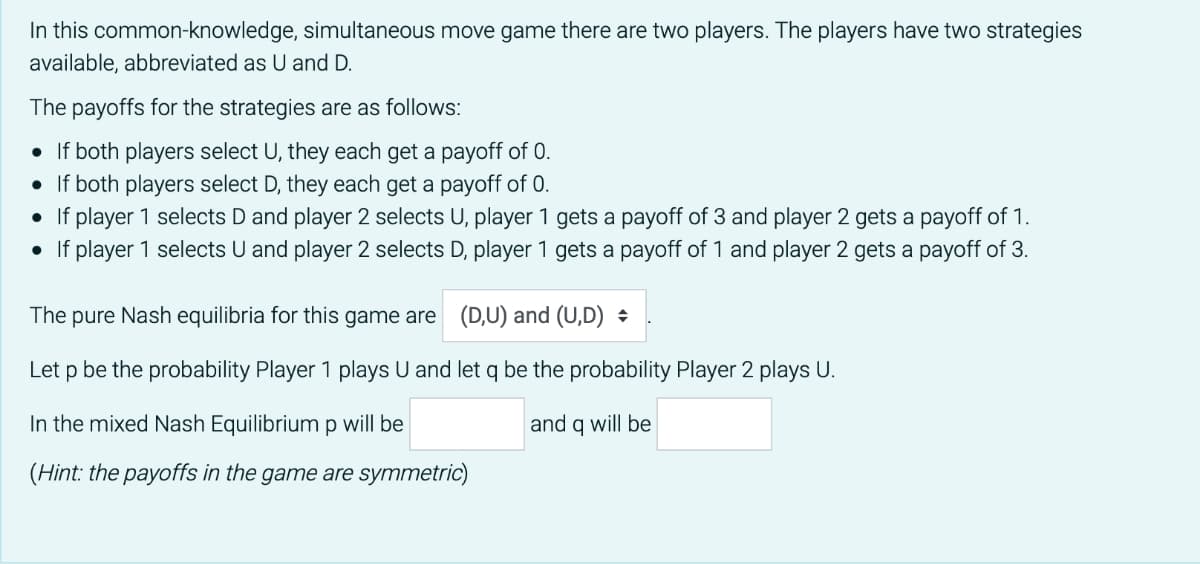In this common-knowledge, simultaneous move game there are two players. The players have two strategies available, abbreviated as U and D. The payoffs for the strategies are as follows: • If both players select U, they each get a payoff of 0. • If both players select D, they each get a payoff of 0. • If player 1 selects D and player 2 selects U, player 1 gets a payoff of 3 and player 2 gets a payoff of 1. • If player 1 selects U and player 2 selects D, player 1 gets a payoff of 1 and player 2 gets a payoff of 3. The pure Nash equilibria for this game are (D,U) and (U,D) + Let p be the probability Player 1 plays U and let q be the probability Player 2 plays U. In the mixed Nash Equilibriump will be and q will be (Hint: the payoffs in the game are symmetric)
In this common-knowledge, simultaneous move game there are two players. The players have two strategies available, abbreviated as U and D. The payoffs for the strategies are as follows: • If both players select U, they each get a payoff of 0. • If both players select D, they each get a payoff of 0. • If player 1 selects D and player 2 selects U, player 1 gets a payoff of 3 and player 2 gets a payoff of 1. • If player 1 selects U and player 2 selects D, player 1 gets a payoff of 1 and player 2 gets a payoff of 3. The pure Nash equilibria for this game are (D,U) and (U,D) + Let p be the probability Player 1 plays U and let q be the probability Player 2 plays U. In the mixed Nash Equilibriump will be and q will be (Hint: the payoffs in the game are symmetric)
Managerial Economics: Applications, Strategies and Tactics (MindTap Course List)
14th Edition
ISBN:9781305506381
Author:James R. McGuigan, R. Charles Moyer, Frederick H.deB. Harris
Publisher:James R. McGuigan, R. Charles Moyer, Frederick H.deB. Harris
Chapter13: best-practice Tactics: Game Theory
Section: Chapter Questions
Problem 11E
Related questions
Question
6

Transcribed Image Text:In this common-knowledge, simultaneous move game there are two players. The players have two strategies
available, abbreviated as U and D.
The payoffs for the strategies are as follows:
• If both players select U, they each get a payoff of 0.
• If both players select D, they each get a payoff of 0.
• If player 1 selects D and player 2 selects U, player 1 gets a payoff of 3 and player 2 gets a payoff of 1.
• If player 1 selects U and player 2 selects D, player 1 gets a payoff of 1 and player 2 gets a payoff of 3.
The pure Nash equilibria for this game are (D,U) and (U,D) :
Let p be the probability Player 1 plays U and let q be the probability Player 2 plays U.
In the mixed Nash Equilibrium p will be
and q will be
(Hint: the payoffs in the game are symmetric)
Expert Solution
This question has been solved!
Explore an expertly crafted, step-by-step solution for a thorough understanding of key concepts.
Step by step
Solved in 2 steps with 2 images

Knowledge Booster
Learn more about
Need a deep-dive on the concept behind this application? Look no further. Learn more about this topic, economics and related others by exploring similar questions and additional content below.Recommended textbooks for you

Managerial Economics: Applications, Strategies an…
Economics
ISBN:
9781305506381
Author:
James R. McGuigan, R. Charles Moyer, Frederick H.deB. Harris
Publisher:
Cengage Learning

Exploring Economics
Economics
ISBN:
9781544336329
Author:
Robert L. Sexton
Publisher:
SAGE Publications, Inc


Managerial Economics: Applications, Strategies an…
Economics
ISBN:
9781305506381
Author:
James R. McGuigan, R. Charles Moyer, Frederick H.deB. Harris
Publisher:
Cengage Learning

Exploring Economics
Economics
ISBN:
9781544336329
Author:
Robert L. Sexton
Publisher:
SAGE Publications, Inc


Managerial Economics: A Problem Solving Approach
Economics
ISBN:
9781337106665
Author:
Luke M. Froeb, Brian T. McCann, Michael R. Ward, Mike Shor
Publisher:
Cengage Learning


Microeconomics: Principles & Policy
Economics
ISBN:
9781337794992
Author:
William J. Baumol, Alan S. Blinder, John L. Solow
Publisher:
Cengage Learning